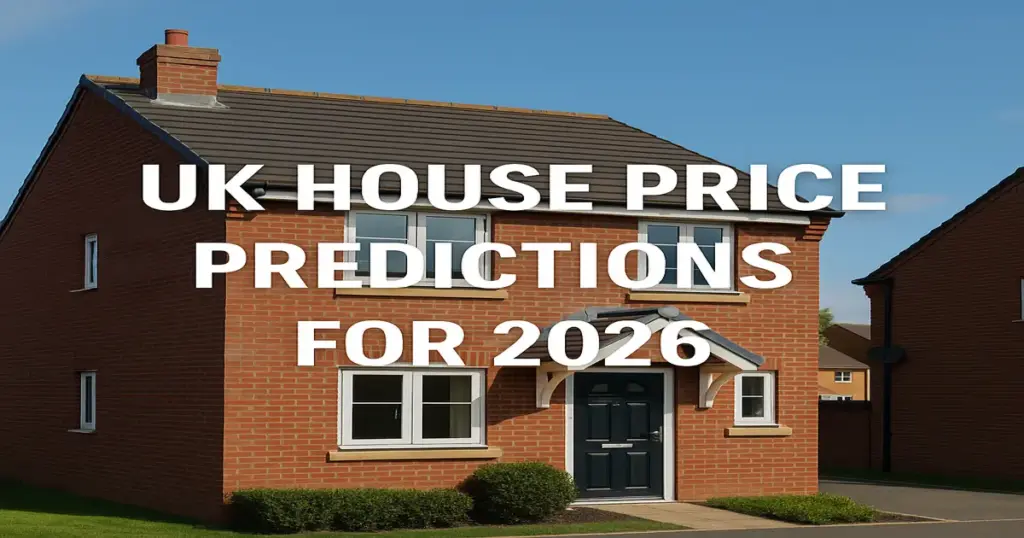What is the House Price Predictions for 2026
The UK housing market has always attracted attention for its perceived stability and potential as an investment vehicle.
As we move through 2025, interest in what lies ahead for 2026 is growing. Will prices continue to rise? Will they stabilise or even fall? What do experts foresee, and what factors will likely shape the market?
This article provides a comprehensive look at the predicted trends in UK house prices for 2026, drawing on expert forecasts, economic indicators, and housing market dynamics.
We’ll explore regional variations, the impact of interest rates, government policy, and supply-demand fundamentals before closing with a detailed FAQ to address common questions.
The 2025 Backdrop: Rebound and Rebalancing
House prices in the UK experienced a resurgence in early 2025, with average prices rising after a brief stagnation during 2023 and early 2024.
This recovery has been driven by a combination of factors, including easing inflation, resilient employment figures, and strong wage growth.
Mortgage rates remain elevated compared to pre-pandemic levels but show signs of softening. Many households are still cautious, yet first-time buyers and uppers have begun re-entering the market more confidently.
Supply, however, remains a persistent issue. New housing completions are below the government’s targets, and the gap between supply and demand continues to place upward pressure on prices.
National Price Predictions for 2026
Looking ahead to 2026, property experts, analysts, and financial institutions agree that UK house prices will likely continue rising, albeit at a more modest and sustainable pace than during the pandemic boom.
Most forecasts place national average house price growth for 2026 between 2.5% and 5.5%, depending on variables such as interest rates, wage growth, and housing supply.
Some property consultancies predict that if mortgage rates fall more significantly than expected, house prices could rise by as much as 7% in 2026. This view is based on pent-up demand and the release of affordability pressures that currently restrict borrowing capacity.
On the other end of the spectrum, more conservative projections suggest 2% to 3% growth, primarily driven by continued caution among buyers and slow progress on housing supply.
Regional Variations: Winners and Laggards
One of the most notable characteristics of the UK housing market is the stark difference in performance between regions.
In recent years, the North East, North West, and parts of the Midlands have seen stronger growth than London and the South East, due mainly to better affordability and significant investment in local economies.
This regional divergence is expected to persist in 2026. Northern cities such as Manchester, Leeds, and Newcastle are forecast to outperform the national average, with projected growth rates of 4% to 6%.
These areas benefit from lower entry prices, urban regeneration projects, and increasing attractiveness to remote workers seeking better value for money.
In contrast, the London market is expected to grow more slowly but steadily. Forecasts for London suggest an annual increase of 3% to 4% in 2026.
The capital has recovered more slowly from recent downturns, with affordability constraints and high property values limiting the scope for rapid increases. However, its global appeal and robust rental market support prices in the medium term.
Interest Rates and Their Impact
The interest rate environment is among the most influential variables for house price trends. The Bank of England raised its base rate several times from 2022 to 2024 in response to inflation. By early 2025, there are signs of a plateau, with economists expecting a gradual reduction in the base rate from its peak.
Should rates decline through 2025 and into 2026, mortgage affordability will improve. This could spur more buying activity, particularly among first-time buyers priced out due to high monthly repayments.
Lower interest rates would also boost buyer confidence and increase demand, exerting upward pressure on house prices. However, if rate cuts are delayed or more limited than anticipated, the impact on the housing market may be muted.
Wage Growth and Affordability
Wage growth in the UK has been robust, with average earnings rising faster than inflation throughout 2024 and early 2025. If this trend continues into 2026, housing affordability will gradually improve, even if property prices continue to increase.
Affordability is a key factor determining buyers’ ability to enter the market. As wages rise, the ability to borrow more or save for deposits improves, which supports demand.
However, if wage growth stalls or inflation picks up unexpectedly, this could reverse some of the recent improvements in buyer affordability and dampen the pace of house price growth.
Housing Supply Constraints
The UK’s housing supply continues to fall short of government targets. Planning delays, construction costs, and a shortage of skilled labour all contribute to the bottleneck.
New builds remain below the 300,000 homes per year target. Even with government incentives and investment in affordable housing, this gap is unlikely to be closed quickly.
The consequence of constrained supply is continued competition among buyers for available properties, likely to support prices. Unless there is a significant increase in housing completions in 2025, supply-side pressures will continue to be a key factor underpinning house price growth in 2026.
Policy and Political Influence
Government policy will also shape the housing market in 2026. Planning reform, tax incentives, and housing investment schemes can all influence market behaviour.
The next general election, expected before or during 2025, may also bring changes in housing policy. Depending on the governing party’s stance, we could see new initiatives aimed at first-time buyers, shifts in taxation, or broader economic strategies that indirectly influence the housing market.
Stamp duty holidays or changes, which have historically influenced transaction volumes and prices, could play a role if implemented.
The Rental Market and Buy-to-Let
The buy-to-let market has faced significant changes in recent years due to tighter regulation, higher taxes, and changing rental dynamics. However, demand for rental properties remains high, particularly in urban centres.
With mortgage rates expected to decline and tenant demand still robust, landlords may find conditions improving slightly in 2026. However, rental yields will continue to be a key consideration. Investors must weigh capital appreciation against increasing compliance costs and regulatory pressure.
Areas with strong local economies and growing populations, like Birmingham and Bristol, will likely remain attractive to investors looking for long-term value.
A Balanced Outlook
Considering these factors, the most probable outlook for UK house prices in 2026 is steady, moderate growth. Most expert predictions fall within the national average’s 3% to 5% range.
Upside potential exists, particularly if interest rates fall quickly or supply constraints worsen. However, the risks are also real—economic shocks, geopolitical instability, or policy missteps could all dampen the market.
Frequently Asked Questions (FAQs)
Will house prices rise or fall in 2026?
Most experts predict that house prices will rise moderately in 2026, with growth expected between 2.5% and 5.5%. Extreme scenarios of sharp increases or declines are considered unlikely unless triggered by major economic events.
Which regions are expected to see the highest growth?
Regions such as the North East, North West, and Midlands are expected to lead growth in 2026. Cities like Manchester, Leeds, and Birmingham are forecast to outperform the national average due to affordability and local development.
What will happen to London house prices in 2026?
London is projected to grow from 3% to 4% in 2026. While it remains a key market, affordability issues and slower recovery post-pandemic have limited recent performance.
How will interest rates affect house prices in 2026?
Falling interest rates would reduce mortgage costs, potentially increasing demand and supporting house price growth. If rates remain high, growth may be limited.
Will buying a home become more affordable?
Affordability will likely improve slightly if wage growth continues and mortgage rates decline. However, with house prices also rising, affordability gains may be offset.
Is 2026 a good year to buy property?
2026 may be a good time to buy, especially if interest rates fall and supply remains tight. Buyers should consider personal financial circumstances and local market conditions.
What are the main risks to the market in 2026?
Key risks include slower economic growth, unexpected inflation, delays in rate cuts, and potential regulatory changes. These could all affect buyer confidence and transaction volumes.
Will the housing shortage be solved by 2026?
It is unlikely. While efforts are being made to increase supply, significant change typically takes several years. Supply constraints are expected to persist through 2026.
How will policy changes influence house prices?
Government incentives, tax policies, and planning reforms can significantly impact. Policy changes that stimulate demand or restrict supply may accelerate price growth.
Should investors consider buying in 2026?
Investors may find value in regional markets with strong rental demand. While yields are under pressure, capital growth prospects and tenant demand remain positive in many areas.
Conclusion
The outlook for UK house prices in 2026 is cautiously optimistic.
With forecasts ranging from 2.5% to 5.5% growth, most analysts agree on moderate appreciation driven by improving affordability, steady demand, and persistent supply issues.
Regional variations will continue to create opportunities for buyers and investors, while policy shifts and macroeconomic conditions will shape the market’s trajectory.
Buyers, sellers, and investors should remain informed and adaptable, keeping an eye on interest rates, wage trends, and policy changes.
The UK housing market may not deliver the explosive growth seen in previous booms, but its underlying resilience and structural dynamics continue to support a positive, if measured, outlook for 2026.
Official and Government Sources
Office for National Statistics (ONS) – UK House Price Index
Office for Budget Responsibility – Economic and Fiscal Outlook
Read our top Blogs:
Sell My Property Fast For Cash In Wandsworth
What to Do If Your House Won’t Sell: Fast Solutions That Work
How to Sell House Fast: Proven Tips to Get a Quick Sale Without Estate Agents
Call +447702210159 our friendly team for a same-day offer





